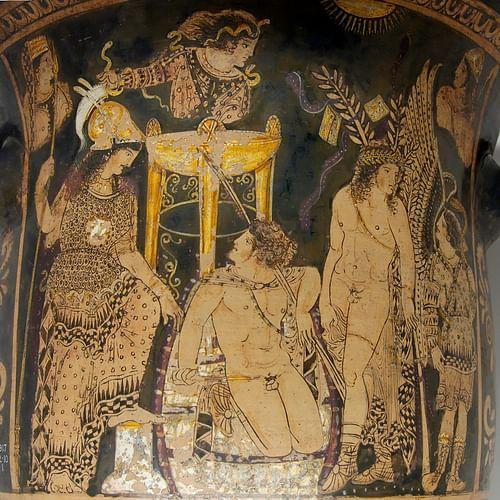The Furies (or Erinyes, sing. Erinys) were creatures from Greek mythology who exacted divine retribution from those guilty of wrong-doing. Crimes which were especially likely to incur their wrath were those involving one's family and anything related to oaths. The Furies were also responsible for carrying out curses, and the punishments they dealt out included disease and madness. From the 5th century BCE they are sometimes referred to by the euphemistic title 'the Gracious Ones' or Eumenides.
Hesiod & Homer
The Furies may go back to prehistoric times in Greece as the word 'Erinys' appears in Linear B and she was long-identified with Demeter, the agricultural goddess, in Arcadia, and with Potnia, the ancient 'Mistress' goddess, in Boeotia. Their earliest mention in literature is in the work of Hesiod and Homer.
In Theogony Hesiod describes their birth but, as with most later sources, he does not specify their number. When the blood from the castrated Uranus hit the earth, from there sprang the Furies. They are, therefore, the daughters of Earth and Sky. Immediately, then, there is a connection with family arguments for Uranus was attacked by his son, the titan Cronus. In Hesiod's Works & Days we are told that the Furies attended the birth of Oath, whose mother was Strife.
In Homer's Iliad the Furies can prevent an individual from using their reason and so lead them to unusual and stupid acts. The example here is of Agamemnon who unwisely stole the prize of Achilles and so upset the hero that he withdrew from the Trojan War. In Book 15 of the Iliad we are reminded that they favour the eldest sibling when Iris reminds Poseidon of the folly of going against his older brother Zeus. Homer also mentions that they live in Erebos, or darkness, and have no pity in their hearts. In the Odyssey Homer describes them as the 'Avenging Furies' and they curse Melampus, king of Argos, with temporary madness.
Associations & Purpose
Goddesses of vengeance and punishers of wrong-doing in general, the Furies were considered protectors of the rights of senior family members, especially mothers, fathers, and elder siblings. A famous example is their pursuit of Orestes after he killed his mother Clytemnestra. The Furies would carry out punishments according to curses given by such members. Outside the family, the Furies protected such social outcasts as beggars. They acted, too, as the guarantors of oaths and the punishers of those who swore false oaths. The dark nature of their task led them to being closely associated with Hades, the Greek Underworld, where they escorted the wicked to their torments. The writer of Greek tragedy Aeschylus, for example, refers to the Furies as the daughters of Night.

The Furies in Art
The Furies appear on Greek pottery decoration, typically with wings and either carrying snakes or with snakes in their hair. They are often seen pursuing Orestes and on other occasions in the company of either Hades or Hecate, the lunar goddess associated with witchcraft. The Furies feature in the works of all three great Greek tragedians, Aeschylus, Sophocles, and Euripides (see especially Orestes). In Aeschylus' plays, they appeared on stage wearing all black and with snakes instead of hair. They continue to appear in Etruscan and Roman art when they become just three, are given the names Allecto, Megaera, and Tisiphone, and are referred to collectively as the Dirae.
